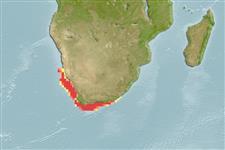Elasmobranchi (squali e razze) (sharks and rays) >
Rajiformes (Skates and rays) >
Rajidae (Skates)
Etymology: Dipturus: Greek, di = two + Greek, pteryx = fin (Ref. 45335).
More on author: Smith.
Environment: milieu / climate zone / depth range / distribution range
Ecologia
marino demersale; distribuzione batimetrica 50 - 457 m (Ref. 5578). Subtropical; 26°S - 36°S, 12°E - 29°E (Ref. 114953)
Southeast Atlantic: known only from Lüderitz, Namibia to Port Alfred, Eastern Cape (South Africa)
Size / Peso / Age
Maturity: Lm ? range ? - ? cm
Max length : 130 cm TL maschio/sesso non determinato; (Ref. 114953)
Short description
Morfologia | Morfometria
A striking two-toned longnose skate, medium brown above and abruptly dark grey below, with a large, conspicuous, dark brown blotch on the upper base of each pectoral fin (Ref. 5578). Snout moderately elongated and bluntly triangular, and tail stout, not conspicuously swollen and about equal to body length; pectoral disc with broadly rounded corners and smooth underside without denticles; thorns at nape and along midline of back and tail to 1st dorsal fin, nape spine enormous in young (Ref. 5578). Hatchlings and juveniles with wide-spaced black spots on upper disc, inconspicuous or lost in adolescents and adults; adults sometimes with numerous small white spots (Ref. 5578). Underside with numerous black pores (Ref. 5578).
Found on soft bottoms of the outer shelf and upper slope (Ref. 5578). Feeds on bony fish, crabs, shrimp, mysids, mantis shrimp, euphausiids, bivalves and cuttlefish (Ref. 5578). Oviparous (Ref. 50449). Eggs have horn-like projections on the shell (Ref. 205). Males reaches maturity at 88-96 cm TL, females possibly slightly larger off Western than Southern coast of South Africa; hatching size at ca. 19 cm TL (Ref. 114953). Commonly taken by hake trawlers (Ref. 5578). Extremely slippery when caught (Ref. 5578).
Life cycle and mating behavior
Maturità | Riproduzione | Deposizione | Uova | Fecundity | Larve
Oviparous, paired eggs are laid. Embryos feed solely on yolk (Ref. 50449). Eggs have horn-like projections on the shell (Ref. 205).
McEachran, J.D. and K.A. Dunn, 1998. Phylogenetic analysis of skates, a morphologically conservative clade of elasmobranchs (Chondrichthyes: Rajidae). Copeia 1998(2):271-290. (Ref. 27314)
IUCN Red List Status (Ref. 130435)
Threat to humans
Harmless
Human uses
Pesca: di nessun interesse
Informazioni ulteriori
BibliografiaAcquacolturaProfilo di acquacolturaVarietàGeneticaElectrophoresesEreditarietàMalattieElaborazioneNutrientsMass conversion
Strumenti
Special reports
Download XML
Fonti Internet
Estimates based on models
Preferred temperature (Ref.
123201): 9.2 - 16.7, mean 11 °C (based on 41 cells).
Phylogenetic diversity index (Ref.
82804): PD
50 = 0.5000 [Uniqueness, from 0.5 = low to 2.0 = high].
Bayesian length-weight: a=0.00372 (0.00249 - 0.00554), b=3.20 (3.08 - 3.32), in cm total length, based on LWR estimates for this species & Genus-body shape (Ref.
93245).
Trophic level (Ref.
69278): 4.1 ±0.69 se; based on food items.
Generation time: 22.0 ( na - na) years. Estimated as median ln(3)/K based on 2
growth studies.
Resilienza (Ref.
120179): Basso, tempo minimo di raddoppiamento della popolazione 4.5 - 14 anni (Fec assumed to be <100).
Fishing Vulnerability (Ref.
59153): Very high vulnerability (75 of 100).
